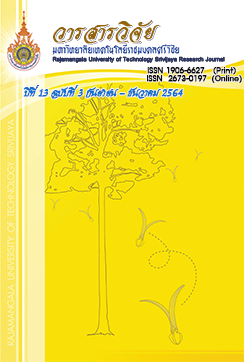Effects of Extracting Conditions of Pigmented Rice Bran on Anthocyanin and Antioxidant Activity and Its Storage Stability
Keywords:
pigmented rice bran, extraction, anthocyanin, rice cultivars, stabilityAbstract
The objectives of this study were to determine the effects of pigmented rice bran (PRB) cultivars and anthocyanin extraction conditions on total phenolic content (TPC), total anthocyanin content (TAC) and DPPH scavenging activity (DPPH) and then to assess conditions for the stability of the optimal anthocyanin. We tested 3 cultivars, 3 particle sizes, shake vs. no shake, 6 solvents, 4 extraction times and 4 temperatures. The results showed that the appropriate cultivar and extraction parameters were Homnil cultivar, 60 mesh particle size, shaking, 2% (w/v) citric acid and extraction for 3 h at 40°C. The TPC, TAC and DPPH scavenging activity were 320 mg gallic acid equivalent (GAE)/100g, 238.02 mg cyanidin /100g and 87.09% respectively. We investigated stability at 3 storage temperatures ranging from 0-63 days and with the presence and absence of light. The results showed that the TPC, TAC and DPPH activity decreased with increasing storage temperature, time and light exposure. Therefore, anthocyanin from pigmented rice bran extract is useful as a bioactive food or beverage ingredient; however, it should be kept under appropriate conditions for stability.
References
Ahuja, U., Ahuja, S.C., Chaudhary, N. and Thakrar, R. 2007. Red Rices-Past, Present, and Future. Asian Agri-History 11: 291-304.
Fera, A., Galih, N.A., Arini, M., Alia, N.F., Sisca, U. and Mimiek, M. 2013. Extraction and stability test of anthocyanin from Buni fruits (Antidesma bunius L) as an alternative natural and safe food colorants. Journal of Food and Pharmaceutical Science 1: 49-53.
Giusti, M.M. and Wrolstad, R.E. 2001. Characterization and measurement of anthocyanins by UV-Vis spectroscopy, pp.26-29. In Wiley. Current protocols in Food Analytical Chemistry Unit F1.2. John Wiley & Sons, Inc., United States.
Hiba, N.R., Nada, El, D., Zeina H., Nadia, B., Eugene, V., Richard, G.M. and Nicolas, L. 2014. Extraction of total phenolic compounds, flavonoids, anthocyanins and tannins from grape byproducts by response surface methodology. Influence of solid-liquid ratio, particle size, time, temperature and solvent mixtures on the optimization process. Food and Nutrition Sciences 5: 397-409.
Jing, P. and Giusti, M.M. 2007. Effects of extraction conditions on improving the yield and quality of an anthocyanin-rich purple corn (Zea mays L.) color extract. Journal of Food Science 72(7): 363-368.
Kannan, A., Hettiarachchy, N.S., Lay, J.O. and R. Liyanage. 2010. Human cancer cell proliferation inhibition by a pentapeptide isolated and characterized from rice bran. Peptides 31: 1629-1634.
Laleh, G.H., Frydoonfar, H., Heidary, R., Jameei, R. and Zare, S. 2006. The effect of light, temperature, pH and species on stability of anthocyanin pigments in four Berberis species. Pakistan Journal of Nutrition 5: 90-92.
Maier, T., Fromm, M., Schieber, A., Kammerer, D.R. and Carle, R. 2009. Process and storage stability of anthocyanins and non-anthocyanin phenolics in pectin and gelatin gels enriched with grape pomace extracts. European Food Research and Technology 229: 949-960.
Maisuthisakul, P. and Changchub, L. 2014. Effect of extraction on phenolic antioxidant of different Thai rice (Oryza sativa L.) genotypes. International Journal Food Properties 17(4): 855-865.
Masuda, T., Yonemori, S., Oyama, Y., Takeda, Y., Tanaka, T. and Andoh, T. 1999. Evaluation of the antioxidant activity of environmental plants: activity of the leaf extracts from seashore plants. Journal of Agricultural and Food Chem 47: 1749-175.
Oki, T., Masuda, M., Kobayash, M., Nishiba, Y., Furuta, S., Suda, I and Sato, T. 2002. Polymeric procyanidins as radical-scavenging components in red-hulled rice. Journal of Agricultural and Food Chemistry 50(26): 7524-7529.
Patrauanu, O.A., Lazer, L., Popa, V.I. and Volf, I. 2019. Influence of particle size and size distribution on kinetic mechanism of spruce bark polyphenols extraction. Cellulose Chemistry and Technology 53: 71-78.
Palamidis, N and Markakis, P. 1975. Stability of grape anthocyanin in a carbonated beverage. Journal of Food Science 40: 1047-1048.
Shao, Y., Xu, F., Sun, X., Bao, J. and Beta, T. 2014. Identification and quantification of phenolic acids and anthocyanins as antioxidants in bran, embryo and endosperm of white, red and black rice kernels (Oryza sativa L.). Journal of Cereal Science 59:211-218.
Song, J., Smart, R., Wang, H., Dambergs, B., Sparrow, A. and Qian, M.C. 2015. Effect of grape bunch sunlight exposure and UV radiation on phenolics and volatile composition of Vitis vinifera L. cv. Pinot noir wine. Food Chemistry 173: 424-431.
Sukhapat, N., Ungphaiboon, S., Itharat, A., Puripattanavong, J. and Pinsuwan, S. 2004. Influence of pH on antioxidant activity of roselle (Hibiscus sabdariffa L.) extract in aqueous solution, p184. In The 10th World Congress on Clinical Nutrition: Nutrition in the Next Decade: Nutraceutical/ Functional Food: Product Performance in Health, Disease and Safety, 30 Nov-3 Dec., 2004. Organized by PSU, INC and BIOTEC, Phuket.
Yoshida, H., Tomiyama, Y. and Mizushina, Y. 2010. Lipid components, fatty acids and triacylglycerol molecular species of black and red rice. Journal of Food Chemistry 123: 210-215.
Downloads
Published
How to Cite
Issue
Section
License
The content and information in the article published in Journal of Rajamangala University of Technology Srivijaya It is the opinion and responsibility of the author of the article. The editorial journals do not need to agree. Or share any responsibility.







